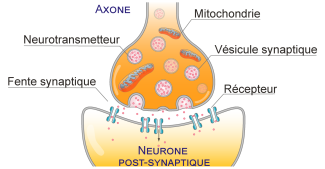Area of contact between the axons of neurons, enabling nerve impulses to be transmitted.
The synapse is a microscopic space that separates two neurons. Although it is only a few tens of nanometres thick, it plays a crucial role in the transmission of nerve information. Activation of a neuron generates an electrical signal called an action potential that causes the release of neurotransmitters into the synapse. These chemical molecules then cross the synaptic slot to reach receptors on the membrane of surrounding neurons, triggering or modulating an action potential in subsequent neurons.
The synapse is highly structured, containing proteins and enzymes that regulate the release, diffusion and degradation of neurotransmitters. This mechanism ensures that information flows accurately and quickly, allowing the brain to coordinate complex functions such as movement, learning, or memory.
Different types of synapses
There are several types of synapses:
- axosomatic synapses (between an axon of neuron A and the cell body membrane of neuron B),
- axo-axonic synapses (between two axons A and B),
- axodendritic synapses (between a neuron A axon and a neuron B dendrite),
- dendrodendritic synapses (between two dendrites).
Structure and mechanisms of synaptic transmission
The synapse consists of three main components:
- the terminal knob of the presynaptic neuron
- the synaptic cleft
- the postsynaptic membrane
The terminal button concentrates synaptic vesicles, which store neurotransmitters. The arrival of an action potential opens the voltage-dependent calcium channels, causing the fusion of vesicles with the membrane and the release of neurotransmitters into the synaptic slot.

Once in the slot, the neurotransmitters diffuse rapidly and attach to specific receptors in the postsynaptic cell. This interaction triggers the opening of ion channels, an inversion of ionic charges inside and outside the neuron, and the propagation of an electrical signal into the next neuron. After their action, enzymes present in the slit or specific transporters recover the neurotransmitters to stop the signal and prepare the synapse for further transmission.
Physiological roles of the synapse
La synapse est au cœur de toutes les fonctions cérébrales. Elle permet aux neurones de communiquer entre eux et d’intégrer des informations provenant de différentes régions du cerveau.
Sa précision est telle que même de petites perturbations peuvent avoir des conséquences importantes. Des anomalies dans la composition de la synapse ou dans la libération des neurotransmetteurs sont impliquées dans de nombreuses maladies neurologiques et psychiatriques, comme la maladie d’Alzheimer, la dépression, l’épilepsie ou la schizophrénie.
The synapse is at the heart of all brain functions. It allows neurons to communicate with each other and integrate information from different regions of the brain.
Its precision is such that even small disturbances can have significant consequences. Abnormalities in the composition of the synapse or in the release of neurotransmitters are implicated in many neurological and psychiatric diseases, such as Alzheimer’s disease, depression, epilepsy or schizophrenia.
Synapse in Research and Medicine
Understanding how the synapse works is essential for the development of new therapies. Researchers use cellular and animal models to observe how neurotransmitters move and interact with their receptors. Advances such as super-resolution imaging and optogenetics make it possible to visualize synaptic activity in real time.
Some therapeutic approaches aim to modulate synaptic transmission. For example, serotonin reuptake inhibitors prolong the presence of this neurotransmitter in the synaptic cleft to treat depression. Research on glutamatergic and GABAergic synapses also opens up avenues for better understanding and treating epilepsy, anxiety or cognitive disorders.
- Neuron :
- Basic cell of the nervous tissue, capable of receiving, analysing, reproducing and transmitting information in the form of an electrical or chemical signal.

